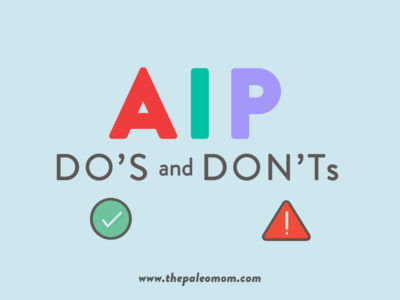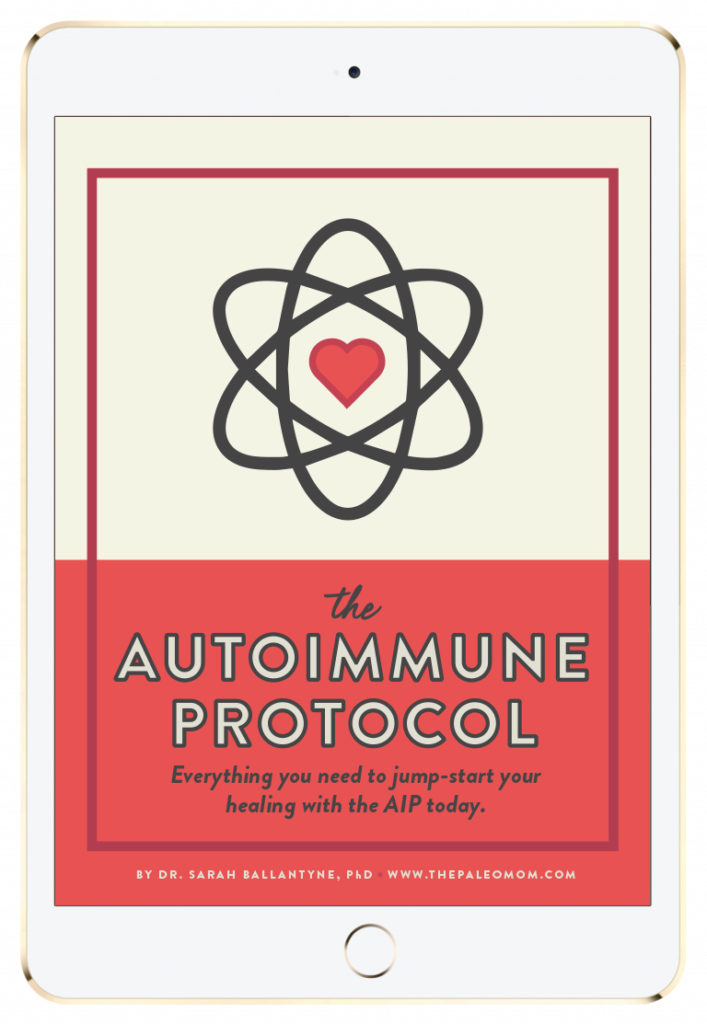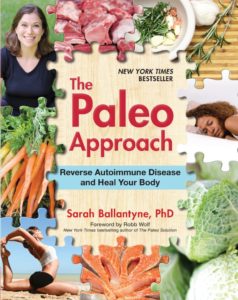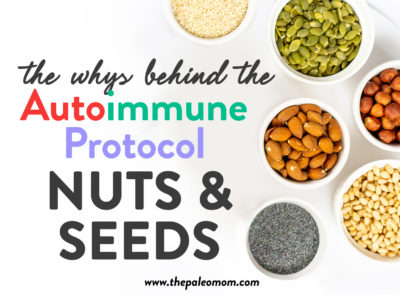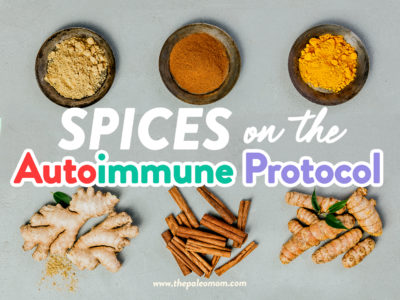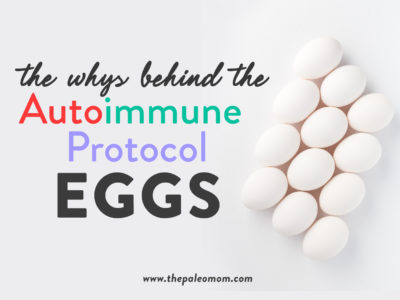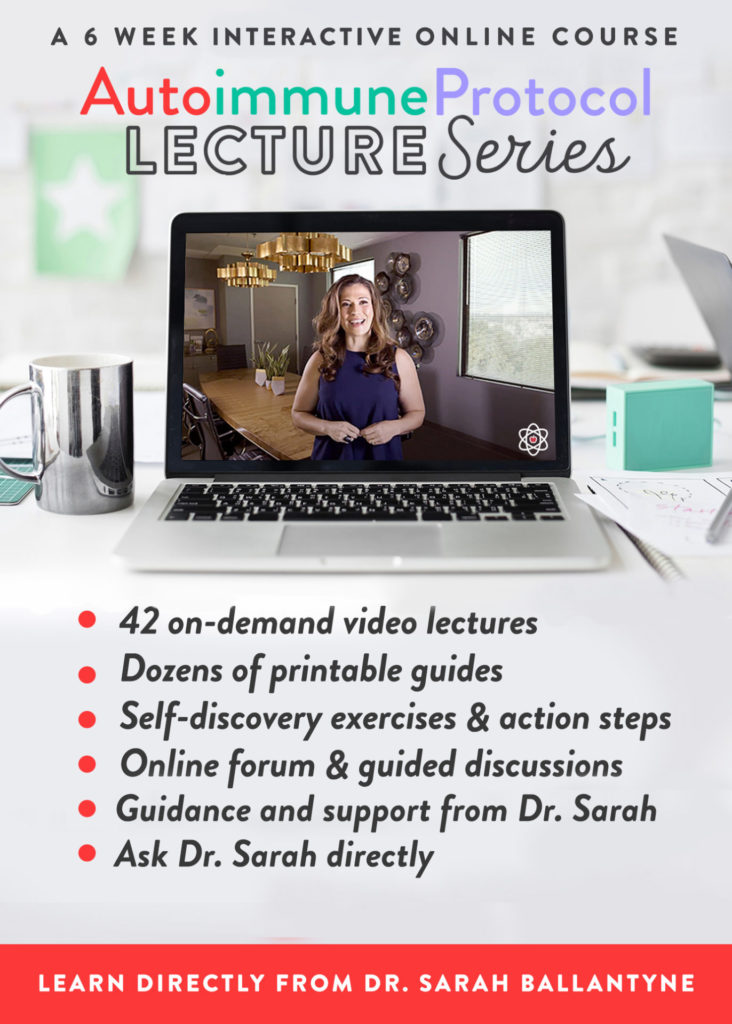 In the last week of my 6-week intensive online course about the Autoimmune Protocol, the AIP Lecture Series, I address many issues related to lifelong health and wellness. Within this week, I cover refinement and personalization of the AIP, troubleshooting, avoiding environmental toxins, working with a functional medicine specialist, reintroductions, advanced gut healing strategies, transition and balance, mindset and priorities for lifelong health. I launch into this last week of the course with a lecture titled “AIP Do’s and Don’ts“, which has become a major discussion point for students every session. Through the self-reflection encouraged as part of this lecture’s Self Discovery Exercise (each of the 42 lectures in the course includes a Self Discovery Exercise, the optional homework for each lecture that amounts to collection of valuable activities and reflections that help reinforce application of the concepts I teach in each lesson), most students realize that they have a particular challenge to fully implementing the AIP (mine is failing to adequately address the stress piece of the equation). Through my guided discussion in the private Facebook Group for the course, students share ideas on how to overcome these challenges with each other, and I am able to lend personalized guidance and support (as I do throughout the six weeks of each session).
In the last week of my 6-week intensive online course about the Autoimmune Protocol, the AIP Lecture Series, I address many issues related to lifelong health and wellness. Within this week, I cover refinement and personalization of the AIP, troubleshooting, avoiding environmental toxins, working with a functional medicine specialist, reintroductions, advanced gut healing strategies, transition and balance, mindset and priorities for lifelong health. I launch into this last week of the course with a lecture titled “AIP Do’s and Don’ts“, which has become a major discussion point for students every session. Through the self-reflection encouraged as part of this lecture’s Self Discovery Exercise (each of the 42 lectures in the course includes a Self Discovery Exercise, the optional homework for each lecture that amounts to collection of valuable activities and reflections that help reinforce application of the concepts I teach in each lesson), most students realize that they have a particular challenge to fully implementing the AIP (mine is failing to adequately address the stress piece of the equation). Through my guided discussion in the private Facebook Group for the course, students share ideas on how to overcome these challenges with each other, and I am able to lend personalized guidance and support (as I do throughout the six weeks of each session).
Table of Contents[Hide][Show]
The 20 AIP Do’s+−
- 1. Eat a variety of nutrient-dense anti-inflammatory foods
- 2. Incorporate superfoods like organ meat, shellfish and sea vegetables into your diet
- 3. Eat a wide variety of vegetables and fruits, getting at least 8-a-day
- 4. Have a healthy relationship with food
- 5. Engage in the local food movement
- 6. Avoid dietary and environmental toxins
- 7. Get plenty of quality sleep
- 8. Be consistent in your bedtime
- 9. Live an active lifestyle, but avoid overtraining
- 10. Actively manage stress and incorporate resilience activities into your day
- 11. Actively work to shore up your support network
- 12. Seek balance and sustainability
- 13. Try some reintroductions
- 14. Work with your doctor to refine and troubleshoot
- 15. Put yourself first
- 16. Communicate with your loved ones about your needs
- 17. Plan ahead and prepare for the unexpected
- 18. Have contingency plans so you can stay on track
- 19. Nurture yourself
- 20. Be patient – it’s called a healing journey for a reason
The 10 AIP Don’ts+−
- 1. Developing/ignoring orthorexia or incompatible goals
- 2. Fearing reintroductions
- 3. Veggiephobia or other food phobia
- 4. Not eating superfoods
- 5. Not eating enough variety
- 6. Ignoring sleep
- 7. Ignoring stress
- 8. Avoiding medications, supplements or other medical treatments that are indicated
- 9. Giving up too early (or never getting there in the first place)
- 10. Holding yourself to impossible standards
As I enter my fifth (!) year of teaching this online course, I am resharing my updated AIP do’s and don’ts to communicate the holistic and comprehensive nature of the Autoimmune Protocol, in addition to helping those of you who have opted to learn about the AIP via other means experience some of the same beneficial self-reflection as my students. The AIP Lecture Series is without a doubt my most effective and comprehensive resource for learning about the Autoimmune Protocol, thanks to my careful layering of information with a multimedia approach plus the highly interactive nature of this online course (I answer every single question and follow-up posed during the session, plus engage with every common on every discussion post—in fact, students are consistently amazed by my thoughtful responses and high level of interaction). However, my virtual classroom is far from the only way to learn the ins and outs of the AIP! You can also do so through self-education (reading my books [especially The Paleo Approach and The Autoimmune Protocol] and/or the vast collection of freely available and up-to-date articles on the AIP on my site, for example), 1-on-1 coaching (like working with an AIP Certified Coach), or group coaching (like SAD to AIP in Six).
No matter how you’ve chosen to learn about the AIP and the why’s behind each facet of this protocol, as you read through the AIP do’s and don’t’s below, I encourage you to reflect. What are the easiest aspects of the Autoimmune Protocol for you to implement? What aspects of the Autoimmune Protocol enrich your life and bring you joy (independent of how healthy they are for you)? What are your biggest hurdles to fully implementing and/or sticking with the Autoimmune Protocol? What can you do to overcome these challenges? Thinking about possible upcoming challenges and identifying practical solutions is also a great way to insulate (at least as much as possible) against surprises that might otherwise derail your efforts. And appreciating the positive aspects of implementing the AIP is an great way to overcome mindset challenges.
 The 20 AIP Do’s
The 20 AIP Do’s
Let’s start with summarizing the AIP do’s, basically a concise list of the fundamental principles on which the Autoimmune Protocol is built in addition to healthy mindset and practical strategies to set yourself up for success.
1. Eat a variety of nutrient-dense anti-inflammatory foods
Nutrient-density (i.e., Nutrivore) is arguably the most important facet of the Autoimmune Protocol, and indeed any healthy eating plan. Each biological system in the human body requires a collection of nutrients in order to function properly, including the immune system, which tends to go into overdrive when we’re deficient in key nutrients (like vitamin A, vitamin D and zinc). In fact, a huge variety of nutritional insufficiencies are linked to increased risk of developing specific autoimmune diseases, and there are even a handful of studies showing targeted supplementation can decrease disease activity, a reflection on just how important these immune health nutrients are. Of course, the AIP goes beyond the nutrient requirements of the immune system and endeavors to achieve nutrient sufficiency, meaning that we get all of the essential and non-essential nutrients our bodies need to thrive in adequate and synergistic quantities from food. Note the variety part of this principle too: variety of whole [AIP] foods equates to variety of nutrients. Check out Chapters 8, 9, 10 and 16 in Paleo Principles to see just how different the nutritional content can be of even highly related foods (like kale vs. collards, or even different cuts of beef!). See also the Autoimmune Protocol, The Importance of Nutrient Density, Essential Nutrient Deficiency and Autoimmune Disease, What Is a Nutrivore?, Fructose and Vitamin D Deficiency: The Perfect Storm?, 7 Nutrients You’re Probably Deficient In, 8 Nutrients for Leaky Gut and 5 Nutrients You’re Deficient In… If You Eat Too Much Sugar.
2. Incorporate superfoods like organ meat, shellfish and sea vegetables into your diet
It’s nearly impossible to achieve nutrient sufficiency without incorporating the nutrient superstar foods like organ meat, fish, shellfish and sea vegetables in the diet. Avoidance of organ meat or “weird foods” is one of variations of food phobia that I encounter in people frustrated at lack of results on the AIP, see AIP, Orthorexia and Food Phobia. The benefits of these nutrient superstar foods are discussed in detail in: Why Everyone Should Be Eating Organ Meat, Why Broth is Awesome, Broth: Hidden Dangers in a Healing Food?, Oysters, Clams, and Mussels, Oh My! Nutrition Powerhouses or Toxic Danger?, Why Seaweed is Amazing! Why Fish is Great for the Gut Microbiome, The Importance of Fish in Our Diets, Why Fish is Great for the Gut Microbiome, The Mercury Content of Seafood: Should we worry?, Should We Be Worried About Radiation from Fukushima?, 3 Painless Ways to “Eat Your Liver”, Why Crickets Are Great for the Gut Microbiome, What The Heck Does Our Liver Do Anyway? Detoxification Explained, The Best Foods and Nutrients to Support Liver Detox, and The Health Benefits of Sea Vegetables.
3. Eat a wide variety of vegetables and fruits, getting at least 8-a-day
I think of Paleo and the Autoimmune Protocol as plant-based diets with two-thirds to three-quarters of every plate covered in fresh vegetables and fruits. Along with being an incredible source of micronutrients, vegetables supply fiber and phytochemicals that can protect against numerous chronic diseases and improve the composition of the gut microbiome. Aim to eat the rainbow (red radishes, orange carrots, dark leafy greens, purple cabbage, white cauliflower, and so on) to ensure that you receive the full spectrum of what vegetables have to offer. And, don’t be afraid of starchy veggies since these are a concentrated source of many important nutrients and eating root vegetables is associated with gut microbiome and diverse health benefits! This is discussed in more detail in: The Importance of Vegetables, The Amazing World of Plant Phytochemicals: Why a diet rich in veggies is so important!, The Diet We’re Meant to Eat, Part 3: How Much Meat versus Veggies?, The Fiber Manifesto-Part 1 of 5: What Is Fiber and Why Is it Good?, The Fiber Manifesto-Part 2 of 5: The Many Types of Fiber, The Fiber Manifesto-Part 3 of 5: Soluble vs. Insoluble Fiber, The Fiber Manifesto-;Part 4 of 5: Fiber, Cholesterol and Bile Salts, The Fiber Manifesto-Part 5 of 5: Busting the Abrasive Insoluble Fiber Myth, Polyphenols: Magic Bullet or Health Hype?, Elevating Mushrooms to Food Group Status, Why Fruit is a Good Source of Carbohydrates, AIP FAQ: Carbohydrate Intake on the Autoimmune Protocol, Cruciferous Vegetables and Thyroid Disease, What Is the Gut Microbiome? And Why Should We Care About It?, Why Root Veggies Are Great for the Gut Microbiome, The Health Benefits of Root Veggies, The Health Benefits of Winter Squash, The Health Benefits of Cruciferous Vegetables, The Health Benefits of the Parsley Veggie Family, The Health Benefits of Leafy Greens, The Health Benefits of Ginger, The Health Benefits of Tropical Fruits, The Health Benefits of Apples, The Health Benefits of Bananas and Plantains, The Health Benefits of Melons, The Health Benefits of Berries and The Health Benefits of Citrus Fruits. Phew!
4. Have a healthy relationship with food
In the AIP Lecture Series, the first week of the course is dedicated to laying the scientific foundation from which we can readily discuss each facet of the Autoimmune Protocol. The second week is focused on the tremendous variety of AIP foods to eat and why. Only after I’ve discussed all the wonderful foods that nourish our bodies that should be on our plates to I discuss elimination. The reason for this is that I have found that it’s much easier to maintain a healthy relationship with food when we focus on all the delicious healthy foods we do eat, rather than perseverate on the old favorites we’re missing out on. Eliminations are still important, but it’s not the foods that you cut out of a diet that determine whether or not that diet is healthy, it’s what you actually put in your mouth that counts! In addition to maintaining this positive mindset when it comes to the AIP diet, it’s important to recognize when we do bring baggage to the AIP (which we all do!) and when that baggage is becoming a problem. I discussed this in detail in AIP, Orthorexia and Food Phobia. Also see AIP Mindset: Optimism, Hope and Healing, AIP Mindset: Putting Myself First, AIP Mindset: Cooking is Not a Burden, AIP Mindset: Getting Beyond Feeling Deprived, and Making Healthy Choices: What’s Your Currency?
5. Engage in the local food movement
Food variety, quality and seasonality are important themes in both the Paleo and AIP communities, and I think the best way to achieve these goals is to plug ourselves into our local food movement. You can do this by shopping at local farmers markets, farm stands, visiting local farms, joining local CSAs, and buying from local independent vendors. If the highest quality foods aren’t available to you geographically or budgetarily, that isn’t necessarily a barrier to healing on the AIP and it certainly doesn’t mean that you can’t follow the AIP. This is where having a thorough understanding of the nutritional difference between a high quality and a lower quality version of a food comes in handy. See also Budget Paleo: Priorities and Strategies, 5 Tips for Eating Paleo On a Budget, Paleo FAQ: “Can I still do Paleo if I can’t afford or source grass-fed beef and organic produce?” , Grass-Fed Beef: A Superfood worth the Premium Price and Olive Oil Redemption: Yes, It’s a Great Cooking Oil!
6. Avoid dietary and environmental toxins
Yes, eliminations are still an important aspect of the AIP (until you’re ready to try reintroductions, of course) and for many people, ditching autoimmune disease triggers and inflammatory stimuli extend beyond their food. Just to get you started (there’s way more detail in both The Paleo Approach and Paleo Principles), check out: Why Grains Are Bad-Part 1, Lectins and the Gut, Are all lectins bad? (and what are lectins, anyway?), How Gluten (and other Prolamins) Damage the Gut, Worse than Gluten: The Agglutinin Class of Lectins, Why Grains Are Bad-Part 2, Omega 3 vs. 6 Fats, Why Grains Are Bad: Part 3, Nutrient Density and Acidity, How Do Grains, Legumes and Dairy Cause a Leaky Gut? Part 2: Saponins and Protease Inhibitors, What Is A Leaky Gut? (And How Can It Cause So Many Health Issues?), Which comes first: the leaky gut or the dysfunctional immune system?, Trans Fats: What Are They, and Why Are They Bad?, Saturated Fat: Healthful, Harmful, or Somewhere In Between?, Which Fats Should You Eat?, The Great Dairy Debate, What Are Nightshades?, The WHYs behind the Autoimmune Protocol: Nightshades, The WHYs behind the Autoimmune Protocol: Alcohol, Nuts and the Paleo Diet: Moderation is Key, The WHYs behind the Autoimmune Protocol: Nuts and Seeds, The WHYs behind the Autoimmune Protocol: Eggs, Is It Paleo? Guar Gum, Xanthan Gum and Lecithin, Oh My!, Is It Paleo? Fructose and Fructose-Based Sweeteners (I’m looking at you, Agave!), Is It Paleo? Splenda, Erythritol, Stevia and other low-calorie sweeteners, What’s the Next Superfood Sweetener?, Coffee and Autoimmune Disease, Is Fructose a Key Player in the Rise of Chronic Health Problems?, 4 Ingredients to Avoid in 2018. Phew!
7. Get plenty of quality sleep
Sleep is so important that I wrote an entire online sleep program called Go To Bed!!! Getting adequate sleep—8 to 9 hours every night for most adults—reduces the risk of a number of chronic diseases (including diabetes, heart disease, stroke, obesity, and autoimmune disease), improves vitality and mood, improves athletic performance and work performance, decreases inflammation, regulates the immune system, regulates hunger and metabolism, reduces stress, and gives us energy throughout the day. It can even help us live longer! You can also read more in Sleep and Disease Risk: Scarier than Zombies!, How Much Sleep Do We Need? Understanding the Hunter-Gatherer Evidence, Sleep Requirements and Debt: How much sleep do you need?, Because Fiber Wasn’t Awesome Enough: New Science Suggests Fiber Improves Sleep Quality!, 10 Tips to Improve Sleep Quality, 5 Ways to Improve Your Bedroom Environment for Sleep, and 4 Biohacks for Better Sleep.
8. Be consistent in your bedtime
Yes, getting sufficient quantity and quality of sleep every single night is super important for immune health, hormonal health, gut health, central nervous system health, cardiovascular health, metabolic health, etc. But, it’s also important to sleep on a consistent schedule, meaning even us grown-ups need bedtimes! This data is best understood in the context of insulin and metabolism, see The Link Between Sleep and Your Weight, The Hormones of Fat: Leptin and Insulin, 3 Ways to Regulate Insulin that Have Nothing to Do With Food, The Case for More Carbs: Insulin’s NonMetabolic Roles in the Human Body, The Hormones of Hunger.
Save 70% Off the AIP Lecture Series!
Learn everything you need to know about the Autoimmune Protocol to regain your health!
I am loving this AIP course and all the information I am receiving. The amount of work you have put into this is amazing and greatly, GREATLY, appreciated. Thank you so much. Taking this course gives me the knowledge I need to understand why my body is doing what it is doing and reinforces my determination to continue along this dietary path to heal it. Invaluable!
Carmen Maier
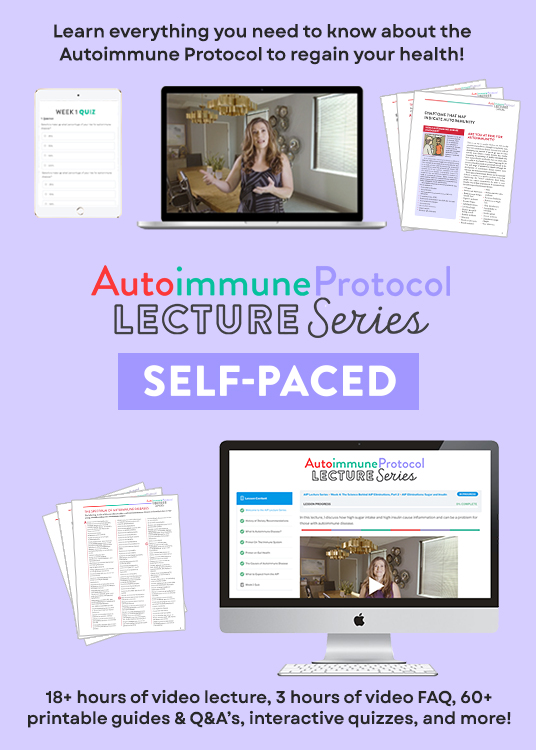
9. Live an active lifestyle, but avoid overtraining
Frequent gentle movement (such as walking, yoga, or stretching), as well as some moderate-intensity activity that you find enjoyable and that works with your particular health situation (such as hiking or lifting weights) can decrease your risk of cardiovascular disease, type 2 diabetes, depression, and some cancers (via immune regulation and metabolic health), as well as improve your mood. At the same time, it’s important to avoid over-exercising, which can create a new set of health problems like immune suppression and leaky gut. See The Importance of Exercise, The Benefits of Gentle Movement, Why Exercising Too Much Hurts Your Gut, and What Is A Leaky Gut? (And How Can It Cause So Many Health Issues?).
10. Actively manage stress and incorporate resilience activities into your day
Reducing unnecessary stress in our lives (including saying “no” to optional activities that would drain us, asking for help when we’re feeling overwhelmed, and reevaluating our goals and priorities), as well as taking measures to better handle the stress we can’t avoid (such as through meditating, spending time in nature, walking, and stretching), helps support healthy hormone function, reduces inflammation, improves immunity and sleep quality, and reduces cravings and uninhibited eating behaviors. Covered under this “do” is addressing mental health challenges (such as addiction or PTSD), HPA axis dysfunction, and other barriers to successful stress management. See also How Stress Undermines Health, How Chronic Stress Leads to Hormone Imbalance, Demystifying Adrenal Fatigue, Pt. 1: What Is Adrenal Fatigue?, Demystifying Adrenal Fatigue, Pt. 2: Testing Adrenal Glandular Function, and Demystifying Adrenal Fatigue, Pt. 3: Nutrition & Lifestyle Support for the Adrenal Glands, The Health Benefits of Nature, AIP Mindset: Optimism, Hope and Healing, TPV Podcast, Episode 319: Abundance Mindset, TWV Podcast Episode 479: Stress, Coffee, Breakfast, and Walking, and TWV Podcast Episode 446: Nutrient Deficiencies Caused by Stress.
11. Actively work to shore up your support network
Social connection provides profound health and longevity benefits, in addition to immune regulatory effects. Even if you’re not close to your family and don’t have a spouse, making an effort to nurture existing relationships or form new ones can go a long way. Even owning a pet has been shown to reduce risk factors for chronic disease and obesity. There’s a practical aspect to connection as well. When we have people in our lives whom we can depend on, we have resources to help us reduce stress and put other priorities, like getting enough physical activity and sleep, at the top of our To Do lists. And having a companion while we tackle the job of healing, whether it’s a walking buddy, a friend to meet up with at the farmers market, someone to watch the kids while we exercise, or a family member to batch cook with on weekends, can make all the difference. See The Health Benefits of Connection and Chapter 30 in Paleo Principles, as well as TWV Podcast Episode 476: Social Isolation – Can Living Like A Hermit Be Healthy?, TWV Podcast Episode 402: The Benefits of Pets (and Sarah’s getting a puppy!) and TPV Podcast Episode 382: Social Media.
12. Seek balance and sustainability
Sustainability is the ability for something to be maintained at a certain rate or level. This can mean many things, depending on which aspect of the AIP we are talking about (environmental sustainability, economic sustainability, etc.). In the context of implementing the dietary and lifestyle facets of the Autoimmune Protocol, the discussion of sustainability means individual sustainability or, rather, your ability to stick with these changes for the long haul. This is made easier by the self-discovery aspect of the Autoimmune Protocol, where you’ve gone through reintroductions and have personalized the AIP to meet your individual needs. But, even before then, it’s important to seek balance. This means finding that mindset where following the AIP is empowering because you are taking the reigns of your health journey, and the give-and-take choices you make are made with intention and in a fully informed capacity. See also AIP, Orthorexia and Food Phobia, AIP Mindset: Optimism, Hope and Healing, AIP Mindset: Putting Myself First, AIP Mindset: Cooking is Not a Burden, AIP Mindset: Getting Beyond Feeling Deprived, and Making Healthy Choices: What’s Your Currency?
13. Try some reintroductions
It’s a surprisingly common experience to feel so good on the AIP that a person is afraid to try any reintroductions. But reintroducing eliminated foods is a critical step of your health journey. This is because some eliminated foods (like eggs, nuts, seeds, cocoa, and grass-fed dairy) have some impressive nutritive value and can improve the overall nutrient density of your diet if well tolerated. Plus, the more dietary flexibility you have, the easier life is—you’ll have less difficulty traveling or eating in restaurants or at potlucks, work meetings, or any social situation. The knowledge you glean from reintroductions is empowering. If a reintroduction goes well, you’ve got a new food to add to your diet, increasing the variety of foods you eat. If a reintroduction doesn’t go well, this is still great information! You now better understand the dietary triggers of your disease and which lines you can’t cross. And in the uncommon case where a reintroduction goes very poorly (the fear of which is what stops many people from even trying), remember that the AIP is an entire toolkit for healing. You have the knowledge and skills to recover quickly and get back on your feet. Just go back to 100% AIP, get plenty of sleep and low-strain activity, and stay hydrated until you feel better. See AIP, Orthorexia and Food Phobia, The 3 Phases of the Autoimmune Protocol and The Reintroduction Phase of the AIP.
14. Work with your doctor to refine and troubleshoot
It’s important to emphasize, that while the AIP is the most expedient diet and lifestyle intervention for autoimmune disease, it does not replace the care of your physician and other healthcare professionals. Instead, it should be seen as a complementary approach to healing, used in conjunction with a functional/integrative approach to health which may include judicious and informed use of medications, supplements, alternative therapies and other medical intervention. The point is to use the best of all worlds to support our healing. Consider working 1-on-1 with an AIP Certified Coach and finding a functional or integrative medicine practitioner. See AIP, Orthorexia and Food Phobia and TPV Podcast Episode 338: Integrative, Functional or Naturopathic?
15. Put yourself first
Informal surveys indicate that there’s a strong correlation between type A individuals and autoimmune disease, as well as people who find themselves in intense caregiving roles. For those of us who feel a strong sense of responsibility and obligation to our family, friends, communities, employers, volunteer organizations, etc., taking care of everything and everybody else, to the detriment of self, it’s easy to become overtasked, and spread so thin that self-care never makes it on to the To Do list. Remember that you are much more effective in looking after others and meeting your obligations when you are healthy. It’s important to make sure that those practical things that are important to do for your health make it onto your To Do list (things like grocery shopping, cooking, getting enough sleep, going for a walk in the woods…), which might mean a re-evaluation of all of the items on the To Do list to re-prioritize. See also AIP Mindset: Putting Myself First.
16. Communicate with your loved ones about your needs
One of the best things you can do to successfully navigate the Autoimmune Protocol is to ask for help. This might mean asking your spouse to cook dinner a couple of times a week, or asking your kids to set the table. This might mean asking your neighbor or a friend to watch your kids so you can take a nap or get errands done more efficiently, or asking a family member to pick up your CSA box for you. This might mean inviting a friend over on the weekend during your batch-cooking day; beyond an extra pair of hands in the kitchen, visiting with a friend makes the time spent cooking much more fun. It’s also important to communicate about your emotional needs to friends and family. Perhaps, it makes you feel frustrated and sad to watch them eat a dessert that contains ingredients you now recognize as trigger foods and it would be easier if they didn’t eat it around you. Maybe you just need a good listener to talk to about your experiences. Even if you’re accustomed to being very self-sufficient, it’s important to recognize that your loved ones do want to help and support you. Tell them exactly what you need so they can be effective!
17. Plan ahead and prepare for the unexpected
The best way to stay on track on the Autoimmune Protocol is to plan ahead. It’s important to know in advance what you’re going to eat on a rushed weeknight, how you’re going to handle getting out the door in a hurry in the morning, and what you’ll do when the rest of your family is enjoying a tempting treat. Planning ahead can be as simple as making a shopping list and sticking to it! Other useful strategies include meal planning, batch cooking, cooking for the freezer, planning meals with lots of leftovers, and preparing ingredients for the week ahead of time (such as chopping up veggies for the week). Having a special indulgence that is just for you can be the difference between feeling a sense of deprivation that drives you to fall off the wagon and feeling pampered and content (I recommend Sweet Apricity and anything from the ShopAIP sweet treats category!). See also See also AIP Mindset: Cooking is Not a Burden, AIP Mindset: Getting Beyond Feeling Deprived, and Making Healthy Choices: What’s Your Currency?
18. Have contingency plans so you can stay on track
This is a natural extension of planning ahead, but now you’re going through the mental exercise of finding solutions ahead of time, just in case something goes wrong. If you’re traveling, think about what you will eat if your flight is delayed, or if you arrive to your hotel in the evening and the grocery store you were going to shop at to stock up on AIP foods is closed. Call a restaurant before making a reservation to make sure they can accommodate your needs (and have a snack in your purse just in case you get there and they can’t!). Do you need ready-made meals in your freezer for evenings that you’re too tired to cook. Do you need an AIP-compliant sweet treat available for when cravings hit to keep you on track (check out Sweet Apricity caramels and the sweet treats category on ShopAIP!). Do you need to go to your doctor’s appointment armed with information to request a test or supplement, or just talk about the AIP? Do you need to have a conversation with your in-laws about not bringing gluten into your home when they come to visit? The more you can think through potential challenges before you’re faced with them, the less you’ll get sidelined unexpectedly. If you’re struggling to stay on track, I highly recommend working with an AIP Certified Coach to help identify for stumbling blocks and work around them!
19. Nurture yourself
I separate this “do” from “putting yourself first” because I believe that nurturing yourself is something a little different. I think of “putting myself first” as making sure that those things that need to get done in a day to support my health get done. Nurturing myself encompasses those things that go above and beyond the basics. In some ways, this is the collection of small ways that I demonstrate my love for myself, treat or spoil myself. This can be as simple as taking time to cuddle up with a good book when I know there are more productive things I could be doing with my time (and not feeling guilty about it!!!!). Or, it could be a getting a massage, or taking time to do my hair and makeup so that I feel pretty. I think it’s common among people who have struggled with their health for a long time to have a lot of negative self-talk. Nurturing yourself is about changing that internal dialogue to self-respect, self-love, and self-care.
20. Be patient – it’s called a healing journey for a reason
How autoimmune disease develops and progresses varies from person to person. Two people may suffer from celiac disease that causes malnutrition, have similar gastrointestinal symptoms, and be dangerously underweight—and to many physicians, it is as simple as diagnosing celiac disease and recommending a gluten-free diet. End of story. However, one of those people may be more deficient in fat-soluble vitamins while the other one is more deficient in magnesium and zinc. These subtleties affect how the body responds to diet and lifestyle changes and how quickly the body heals. The differences among people create a complex set of factors that make each person’s disease so distinctive that it is impossible to predict how long healing will take or how rigidly each person will have to adhere to the AIP for how long before trying reintroductions versus digging deeper with a functional medicine specialist. The good news is that healing is a process, and the vast majority of people will notice improvement in their symptoms long, long, long before the process is complete. As your body heals, it will become easier to identify triggers in your diet and elsewhere in your life. Over time, you will figure out what the most important dietary factors are for you personally—both foods to avoid and foods to prioritize. Over time, lifestyle triggers will also become blatantly obvious, to the point that you will probably be able to predict exactly how you will feel as a result of a night of lost sleep or an additional stressor at work. This understanding of your own body will help you continue to make healthful lifestyle choices to prioritize your health. The self-discovery aspect of the Autoimmune Protocol, discussed in The 3 Phases of the Autoimmune Protocol, will allow you to find what works for you, the lines you can’t cross, and your wiggle room.
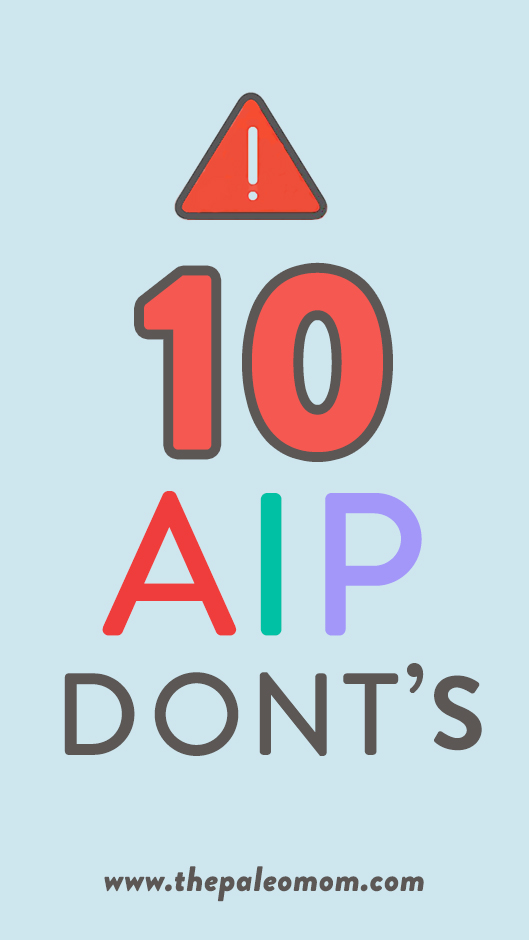
The 10 AIP Don’ts
I built this list of AIP don’ts over years of talking with people at live events, interacting on social media, and answering e-mails and podcast questions. It’s a compilation of those most common stumbling blocks that I observe, responsible for people not experiencing the symptom improvement they were hoping for when adopting the AIP. Some of these are opposites of AIP do’s, basically missing some critical facet of the protocol related to diet, lifestyle, refinement, troubleshooting, mindset, or respecting the journey. But, others represent a fundamental misalignment with the foundational principles of the Autoimmune Protocol. For example, if you aren’t eating nutrient-dense superfoods, you aren’t following the most important facet of the AIP. I would be hard-pressed to call eating a diet that omitted these nutritionally invaluable foods as one that qualifies as AIP.
1. Developing/ignoring orthorexia or incompatible goals
Orthorexia is an eating disorder characterized by an unhealthy obsession with only eating those foods that are deemed “healthy”. It doesn’t matter if the foods are actually healthy, but rather that you have labelled them as such, so you can be orthorexic and vegan, or Paleo, or AIP, or calorie-counting, or low-fat, or keto…. It’s important to seek treatment for orthorexia, which may include relaxing dietary choices until a healthier relationship with food can be established. This is discussed more in AIP, Orthorexia and Food Phobia.
Another aspect of this don’t is focusing on goals that are incompatible with the AIP, for example endurance athlete performance (see Why Exercising Too Much Hurts Your Gut) or weight loss. In fact, my most recent deep dive into the scientific literature reveals that we actually can be healthy at any size, that science has failed to show that losing weight actually improves health, and that the far more important thing is to improve health-related behaviors, which is what the AIP is all about! If you’re hoping to lose weight on the AIP, or scared of gaining weight on the AIP, please engage with my detailed resources on weight stigma: Can You Really Be Healthy at Any Size?, TWV Podcast Episode 471: The Harm of Weight Discrimination and Stigma – Part 1 and TWV Podcast Episode 472: The Harm of Weight Discrimination and Stigma – Part 2.
2. Fearing reintroductions
Reintroductions should be considered part of the AIP. It’s so important, both for self-discovery and diet expansion. I’ve talked about this in detail above, and in AIP, Orthorexia and Food Phobia, The 3 Phases of the Autoimmune Protocol, and The Reintroduction Phase of the AIP
3. Veggiephobia or other food phobia
A food-phobic implementation of the AIP is problematic from a nutrient-sufficiency standpoint as well as a mental health standpoint. By overly restricting the diet, nutrient variety and synergy is reduced, and nutrient insufficiencies can be worsened. I’ve discussed this in detail in Veggiephobia: Why limiting your vegetable intake might be slowing down healing and AIP, Orthorexia and Food Phobia. This can also be a result of calorie, carb or fat restriction for weight loss goals. Again, the goal of the AIP is to improve health, and this is not compatible with a primary focus on losing weight (although, if you are overweight, you may lose weight on the AIP, this is because your body is ready to be smaller not because you were trying), see Can You Really Be Healthy at Any Size?, TWV Podcast Episode 471: The Harm of Weight Discrimination and Stigma – Part 1 and TWV Podcast Episode 472: The Harm of Weight Discrimination and Stigma – Part 2.
4. Not eating superfoods
It’s near impossible to achieve nutrient sufficiency without basing your diet on nutrient-dense superfoods, including organ meat, seafood, and vegetables (and rounding out with other healthy choices like fruit, healthy fats, fresh herbs, meat and poultry). Not to mention restoring adequate levels of any nutrients you might be deficient in before you start the AIP! Check out all the links in Do’s #2 and #3 above and AIP, Orthorexia and Food Phobia.
5. Not eating enough variety
Stuck in a rut? That’s not cool from a nutrient standpoint! The more we can vary the foods on our plates day to day and season to season, the higher our chances of achieving nutrient sufficiency. Mix up the types of vegetables you eat, look for fun varieties of your staples (like purple carrots or heirloom lettuce), eat meats from different animals, and embrace snout-to-tail ideals. The single best way to ensure that we are getting the nutrition our bodies need is to eat as much variety as possible. This means variety in both the plant foods and the animal foods we are eating. Check out Chapters 8 thru 16 in Paleo Principles.
6. Ignoring sleep
Not getting enough sleep, by itself, is inflammatory. And, sleeping in on the weekend is not sufficient to return inflammation levels to normal. The importance of sleep just can not be understated. If this is a challenge for you, I highly recommend getting my online sleep program Go To Bed.
7. Ignoring stress
Guilty as charged (see My Personal Battles with Stress) and I know I’m not alone in this one! I have to be constantly vigilant about my behaviors relating to stress, and while I’ve been more successful at this the last few years, I think managing my stress will be a lifelong endeavor. Remember that stress and sleep are linked: the best thing you can do to manage stress is get enough sleep and the best thing you can do to support sleep quality is manage stress. That means that focusing on both together is very helpful! See Chapters 26 and 27 in Paleo Principles.
8. Avoiding medications, supplements or other medical treatments that are indicated
Autoimmune disease can be challenging to diagnose because it often presents as a collection of vague symptoms (such as fatigue, headaches, and muscle or joint aches). Too often these symptoms are dismissed as signs of getting insufficient sleep, working too hard, stress, being over- or underweight, or age. In fact, a survey performed by AARDA showed that the majority of patients later found to have serious autoimmune conditions had a difficult time obtaining a diagnosis: 45% of them were labeled hypochondriacs in the earliest stages of their illnesses. So, it’s no wonder that it’s so common for autoimmune disease sufferers who have discovered the therapeutic potential of the Autoimmune Protocol to want to fire their doctors, discontinue every steroid and DMARD and painkiller, and never walk into an exam room again. But, it’s really (really, really, really) important to be medically supervised as you’re making changes, to always discuss supplements and medications with a qualified health professional, and rather than eschewing all medical intervention, embracing the powerful tools that conventional medicine have to offer us with informed and judicious use of additional treatments and therapies. Medication is not failure. Requiring medical intervention doesn’t mean that you didn’t “AIP hard enough”, but it also doesn’t get you off the hook for making all those important healthy choices on a daily basis. And, if you aren’t seeing any improvement within 3 or 4 months on the Elimination Phase of the AIP (and you’re doing everything in this article), then it’s really important to find an advanced practitioner to work with to help identify underlying health challenges that are inhibiting your body from responding to all the good choices you’re making. See TPV Podcast Episode 338: Integrative, Functional or Naturopathic?
9. Giving up too early (or never getting there in the first place)
Sometimes people get stuck in the Elimination Phase of the AIP, but this “don’t” is the opposite of that: giving up too early. Healing takes time. How long it will take your body to heal enough for you to notice an improvement in the symptoms of your disease depends on a wide variety of factors: how leaky your gut is, how inflamed your body is, exactly what types of antibodies your body is producing, and which cells in your body they are attacking. It depends on how much damage has been done to which tissues and which hormones are dysregulated and to what degree. Just as your genes will predispose you to developing autoimmunity, they also dictate how easy it is for your body to stop producing those antibodies and for your body to heal. It’s quite hard to predict who will experience earth-shatteringly rapid improvement and who will have a long, drawn-out recovery. Just as it’s important to troubleshoot with a functional medicine specialist when you aren’t seeing results, some patience is also required. Most of us experience incremental improvement that’s really only impressive when we look back at our healing journeys—not noticing differences day to day, but being able to point to healing month to month. Being patient can be especially challenging if you opt for a step-by-step transition (especially if you’re one of those people who are super sensitive to a food you haven’t eliminated yet), so avoid giving up before you ever even fully transition to the AIP. See Transitions: All In or Baby Steps?
10. Holding yourself to impossible standards
The AIP can be thought of as a collection of best practices when it comes to diet and lifestyle to support healing, not to the exclusion of other treatments and therapies, and respecting bio-individuality via self-discovery. Does that mean we need to do every single thing right every single day in order to be a successful AIPer? No! Don’t let perfection be the enemy of the good. It’s okay to have a give and take, to make compromises, to let things slide from time to time, to make a sub-optimal choice, to stumble, to pick yourself back up again… it’s okay to be human. Yes, a slip-up can set you back, but if you’ve created a set of expectations for yourself following the AIP that is causing high stress, and especially if it’s causing an on-the-wagon-off-the-wagon cycle, it’s important to re-evaluate, again seeking balance and sustainability. And here’s where I make one final plug for my AIP Lecture Series because understanding the ins and outs of the AIP is really key to navigating its principles and applying them successfully and efficiently.
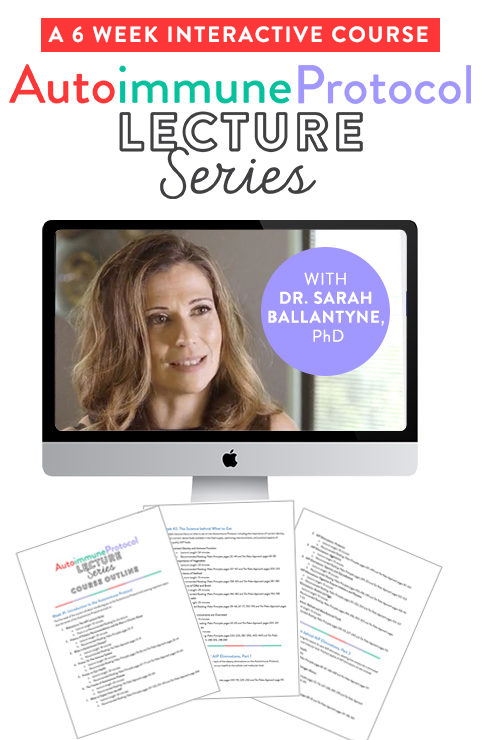 Phew! Yes, that’s a lot to think about. But, on one final note, remember that your AIP learning doesn’t need to happen overnight! You can continue to learn as you implement. This week marks 8 years since I launched my website and started my AIP journey (happy blog anniversary to me!). I’ve learned so much along the way, not just the science, the physiology and biology, but also the intersection with psychology, practical how-to’s, and the importance of a strong knowledge base to make informed decisions. That’s why I so firmly believe that a thorough understanding of the AIP is key to using it successfully and sustainably, whether that’s through self-education (reading my books and/or the vast collection of articles linked above, for example), 1-on-1 coaching (like working with an AIP Certified Coach), group coaching (like SAD to AIP in Six), or my personal favorite, a virtual classroom like the AIP Lecture Series. However you choose to start your AIP journey, remember it begins with taking that first step.
Phew! Yes, that’s a lot to think about. But, on one final note, remember that your AIP learning doesn’t need to happen overnight! You can continue to learn as you implement. This week marks 8 years since I launched my website and started my AIP journey (happy blog anniversary to me!). I’ve learned so much along the way, not just the science, the physiology and biology, but also the intersection with psychology, practical how-to’s, and the importance of a strong knowledge base to make informed decisions. That’s why I so firmly believe that a thorough understanding of the AIP is key to using it successfully and sustainably, whether that’s through self-education (reading my books and/or the vast collection of articles linked above, for example), 1-on-1 coaching (like working with an AIP Certified Coach), group coaching (like SAD to AIP in Six), or my personal favorite, a virtual classroom like the AIP Lecture Series. However you choose to start your AIP journey, remember it begins with taking that first step.

